11025 A RARE FRENCH RESTORATION COFFRE DE MARIAGE, DECORATED WITH GILDED PAPER, SILK AND PANELS OF PEINTURE SOUS VERRE INVERSÉ INCLUDING FIVE SCENES FROM THE STORY OF PAUL ET VIRGINIE French. Circa 1825. Measurements: Height: 7 1/2″ (19 cm) Width: 17 1/3″ (44 cm) Depth: 12 3/4″ (32.3 cm).
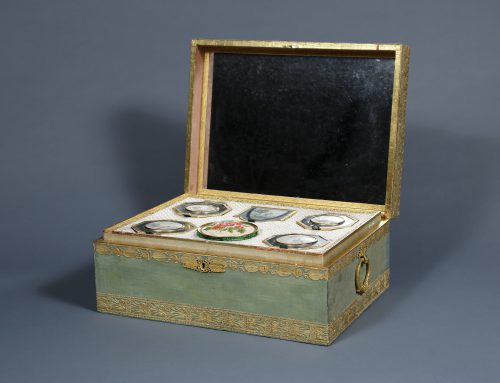
Research
Of carton pierre, green silk , reverse painted glass, gilt bronze. The lid of peinture sous verre or back-painted glass, central oval reserve with a scene, surrounded by an elaborate gilded pattern, the whole panel held in place with fabric. Back, front and sides covered with silk with elaborate detailing around lower and upper edges of stamped and gilded paper. Gilt bronze foliate escutcheon with original lock and gilt bronze oval ring handles on either side. Lid articulated with exterior metal hinges and interior fabric straps, inside with original mirror plate, surrounded by woven fringing. Lower section with fitted but removable section with a ground of woven silk set all around with stamped and gilded carton pierre border, containing six openings of differing shapes bearing engraved images from the story of Paul et Virginie, five with a peinture sous verre scene surrounded by mirror glass on hinges and one removable with an embroidered floral design, all with gilded and stamped metallic borders. Below is space for storage. Some repairs to carton pierre decoration.
Provenance:
UK Private Collection
The tradition of the presentation of a wedding chest exists in a number of cultures. In Europe an example is the Italian cassone, a large and elaborately decorated coffer filled with the bride’s possessions, which would be gifted to the newlywed by her parents. The tradition was also pronounced in France, although by the nineteenth century it was more usual for the coffre de mariage to be given to the wife by her new husband. This is the purpose for which the present piece was made.
Coffres de mariage evolved over time to provide increased practical usefulness, and this example has been adapted as a lady’s travelling box, with space for garments and possessions in the lower section, as well as six compartments for cosmetics and a mirror in the lid. These pieces would often be decorated with iconography referring to matrimonial bliss and a happy family life, a tradition, which is also in evidence in this case. The lid of the box bears a central reserve with an illustration of two gods of antiquity drinking from the cup of friendship: Cupid, representing love and desire, and Hymen, representing marriage. This subject was popular in the early nineteenth century during the Romantic age, as reflected by Jean-Baptiste Regnault’s (1754-1829) version of 1820 in the Louvre (figure 1) and a sculpture of the gods entitled Cupid Rekindling the Torch of Hymen by George Rennie (1801-1860) in the Victoria and Albert Museum of 1831.
In the illustration on the present piece the stone pedestal on which the nymph reposes, who proffers the cup of friendship, bears an inscription that proclaims in clear letters, “de près et de loin”, or “near and far”. This was a phrase often associated with matrimonial bliss in France. It was the title used by the French romantic novelist Paul Lacroix for his Roman Conjugal, or Marital Romance of 1837.1 In this instance it could hold a double meaning, referring to our box’s intended use when travelling. Surrounding this central panel are four words that still often appear in congratulatory messages in France on the occasion of a marriage; sentiment (feeling/emotion), tendresse (tenderness), felicité (bliss) and bonheur (happiness).
The interior cosmetic compartments are each decorated with scenes from a seminal work of French literature, the story of Paul et Virginie by Jacques-Henri Bernardin de Saint-Pierre (1737-1814). It is an undoubted milestone in the emergence of the Romantic Movement, and its publication in 1788, a short time before the French Revolution, appears to have represented the mood of the nation, which was on the verge of breaking with the old order criticised in the book in the most explosive fashion. Set on the Island of Mauritius, which was at that time the French colony of Isle de France, it tells of a love of the utmost purity, between two young people of differing social backgrounds, existing in an idealised and exotic pastoral environment, free from the antiquated and intransigent restraints of society back in France. It is when the demands of this moribund society eventually interfere with their happy life that the pair are split and the tragic ending eventually ensues. As the author himself wrote “I wanted to reunite beauty and the nature of the tropics, and the moral beauty of a miniature society. I also proposed to show in evidence many great truths, amongst others, that our happiness lies in living in the ways of nature and virtue”.2 Bernardin de Saint-Pierre was a close friend to Jean-Jacques Rousseau (1712-1778), perhaps the most celebrated philosopher of the early Romantic Movement in Europe, his beliefs and arguments closely shape the formulation of the story.
It was immediately popular, and remained so throughout the nineteenth century. Some literary historians have celebrated it as the first ever best seller, eventually being translated into thirty languages and selling 25 million copies.3 The illustrations of the story were initially supervised by Bernardin de Saint-Pierre himself,4 and imagery from the story would appear on a wide range of fine and decorative objects during the early nineteenth century, including printed paper and fabrics (figure 2), ceramics, clocks and jewellery boxes. The scenes featured on the inside of this piece refer to an established series of illustrations that would have been instantly recognisable to the French public of the early nineteenth century. Two of the interior lids depict two halves of one scene, often called Paul et Virginie Surpris par la Pluie, the first showing the pair sheltering from the rain using Virginie’s shawl, the second a farmer and his dog emerging from the palm groves with his dog to find them. Another of the compartments shows Le Bienfaisance de Virginie, when the heroine feeds a destitute and fugitive slave. We can also see Virginie est blessé aux pieds, showing Paul tying a bandage on to her feet, a scene that in modern times looks perfectly innocent, but in the early nineteenth century would have had erotic overtones. The final tragic conclusion of the story, the drowning of Virginie in a shipwreck, is not represented here; perhaps such a scene was considered too sad for an object that was intended to commemorate the happy moment of marriage. However, on one of the present lids we see Paul jumping into the water to in a desperate and ultimately unsuccessful attempt to save his beloved. The compelling romance of this story transgressed national and social boundaries; in 1851 Prince Albert bought a sculpture of Paul et Virginie by Jean Geefs at the Great Exhibition to present to his wife Queen Victoria; it must have been a favorite piece as its exotically-styled base was a later gift from the Prince to his wife at Christmas the following year. It remains in the Royal Collection to this day.5
One coffre, sold on the French art market, although less extravagant, shares with the present piece the use of embossed gilded paper, hand colored engravings and mirrors used as decorative feature. Importantly, it also retains a printed velvet pin cushion decorated with flowers, much as in the central lid on the present piece (figure 3). Another example, also with stamped, embossed gilded paper, verre eglomise mirror and an applied hand colored print of a romantic subject, bears its maker’s label, “Sijas Fils à Lyon” (figure 4). In the Almanac de commerce de Paris, des departments de la France et les principales villes du monde, this firm is listed in 1820 as a “Papetier” in the Rhône area of France.6
The present coffre is the largest and most developed of this small group in existence. It combines the whole array of media including verre eglomisé, peinture sur verre inversé, where a piece of glass is painted with the aim of rendering an intricate image on its reverse , embossed and gilded paper, gilt bronze hand colored engraving and it retains its fine outer green silk covering. It represents an important survival of an item produced by the burgeoning French luxury industry.
This piece compellingly conveys much about the time from which it comes. It is a personal object, designed as a token of love, which represents the great age of romanticism and its preponderant literary preoccupations. Yet simultaneously, the innovative methods employed in its creation and decoration remind us also of the exciting diversification of techniques and modes of production that were equally typical of the age.
Footnotes:
1. Paul Lacroix or Paul L Jacob, De près et de loin: roman conjugal, Paris 1837
2. Elisabeth Leprêtre ed., Paul et Virginie: Un Exotisme Enchanteur, Le Havre 2013, p. 32
3. Ibid., p. 33
4. Ibid., p. 52
5. Royal Collection number 41033
6. Almanac de commerce de Paris, des departments de la France et les principales villes du monde, Paris 1820, p. 946
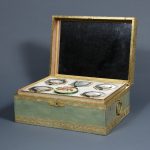

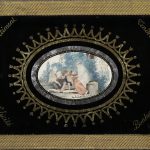

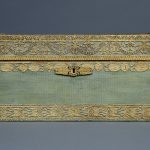


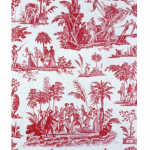
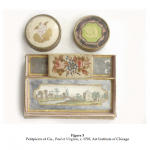
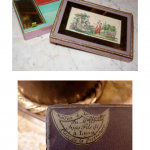
Comments are closed.